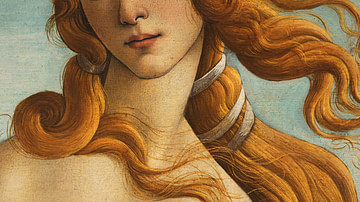
The Graces (also Charites, sing. Charis) were goddesses from Greek mythology who personified charm, grace, and beauty. Hesiod describes three Graces, and this is their most common grouping in literature and art, but their number varies depending on the source. Associated with Aphrodite and spring flowers especially, they were considered the youthful bestowers of beauty in all its forms, from physical to intellectual, artistic to moral.
Hesiod & Homer
In Theogony Hesiod describes three Graces: Aglaea (personifying Radiance), Euphrosyne (Joy), and Thalia (Flowering). He reports that their parents were Zeus and Eurynome, the daughter of Ocean. Hesiod describes them as 'beautiful-cheeked' and 'from their eyes desire, the limb-melter, trickles down when they look; and they look beautifully from under their eyebrows' (907). He goes on to mention that Aglaea, the youngest Grace, became the wife of the craftsman god Hephaistos. The Graces live on Mt. Olympus with the Muses and Himeros, the personification of Desire. In Hesiod's Works & Days the Graces help at the birth of Pandora and, along with the Horae (goddesses of the seasons), are given the task of beautifying the first woman and covering her in flowers, garlands, and fine jewellery. The Graces are described as masters of dancing, singing, and poetry, in which capacity they entertained the guests at the wedding of Peleus and Thetis.
Homer mentions them in both the Iliad and Odyssey but does not specify either their names or number. He associates them with Aphrodite, and this tradition is maintained in later sources with the Graces becoming an established part of the goddess' large entourage. In Book 5 of the Iliad, Homer tells us that the Graces made a beautiful and immortal robe for Aphrodite. Homer goes on in Book 14 to say that Hera gave the Grace Pasithee to Sleep to be his wife in return for him ensuring Zeus was temporarily removed from the action of the Trojan War. The Graces pop up again in Homer's Odyssey where they dispense beauty to mortals and are the handmaidens of Aphrodite, bathing the goddess and anointing her with scented oil in her sanctuary on Cyprus.
Hellenistic Additions & Cults
In the Hellenistic period, the poet Hermesianax added another Grace to the traditional group, that of Peitho, who personified Persuasion. From this period onwards the Graces are linked with Hecate, the lunar goddess associated with magic and ghosts. The Graces became closely associated with flowers, especially roses (which they help grow) and myrtles but also any spring flowers in general. They are often in the company of fertility gods, helped by their experience at the births of Aphrodite and Pandora.
The Graces were the subject of cult worship across the Greek world, but especially southern Greece and Asia Minor. They were particularly important at Orchomenus in Arcadia where they had an annual festival, the Charitesia, held in their honour. Pausanias mentions that they were there associated with meteorites or shooting stars. The historian goes on to list various names of Graces at different cities, for example, Auxo and Hegemone at Athens, and Kleta and Phaenna at Sparta. These were no doubt local deities incorporated into the wider Greek cult of the Graces. In Athens, from the 3rd century BCE, the Graces and Aphrodite were linked to Demos, the personification of the people as attested by an inscribed altar.

The Graces in Art
The Graces can be difficult to identify in art as they have no particular attributes but they are most commonly portrayed as a trio of beautiful young women in Greek and Roman art where they either dance or move in a procession. They appeared in Archaic and Classical Greek art on pottery, relief sculpture, coins, and even on the throne of Zeus at Olympia according to Pausanias. The Graces appear on the famous black-figure Francoise Vase (c. 570 BCE) in a scene from the wedding of Thetis and Peleus and in a much-copied marble relief plaque by Sokrates (c. 470 BCE) where they are in typical processional pose and hold hands.
As with other similar deities representing beauty the Graces were originally portrayed clothed in Greek art but gradually convention came to portray them naked. The Hellenistic Period saw the first example sculptures where they are three standing naked women embracing and this became a much-copied theme in Roman and later art. The Graces were especially popular in Renaissance art. An example is Botticelli's Birth of Venus (1486) where a lone Grace stands on the right, ready to offer the emerging goddess a robe to cover her modesty.





